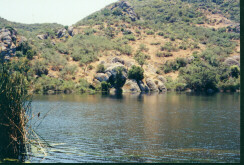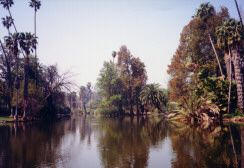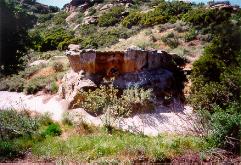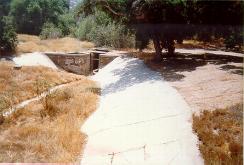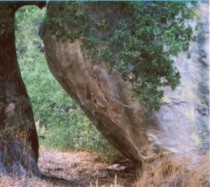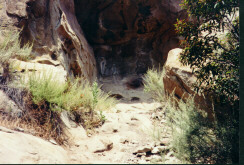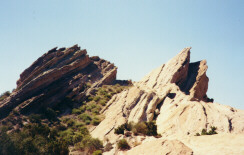Film
Locations
The
MGM Films
The early Tarzan films were shot in the
Lake
Sherwood area. Other exterior shots
included Sherwood Forest, where aerialist Alfredo Codona doubled for
Weissmuller swinging through the trees.
Woodland Park near Pico-Rivera in Whittier (Swamp),
Big Tujunga, China Flats, the Arboretum in Arcadia, and Iverson's
Ranch, specifically the Garden of the Gods site, were also used. The
remaining filming was done on the MGM lot.
The Escarpment (a.k.a. Tarzan Rocks) was located at
the west-end of lot one, as were the river/lake and sound stages. The
top of the escarpment was on lot two and in Sherwood Forest.
The completed tree-house was first seen in the
released version of Tarzan Escapes,
and was built at Crater Camp, in what is now the Malibu Creek State
Park, and duplicated on a stage at MGM. The interiors were on another
sound stage.
|
When the filming of Tarzan
Finds a Son! was nearing completion, it
was decided to send Weissmuller and Sheffield to Silver Springs,
Florida, to get some underwater footage. The waters there were
crystal clear, and afforded some splendid sequences. A Florida
resident was used to double for Maureen O'Sullivan, who remained in
California. Additional footage was shot at Wakulla Springs for Tarzan's
Secret Treasure.
For Tarzan's New York Adventure,
the Hagenbecker-Wallace circus was hired and put on the MGM backlot.
Some second unit shots of New York City were done on location without
the cast. |
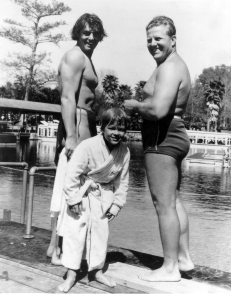
Big John, Little John, and Silver Springs Manager Newt Perry |
The
RKO Films
RKO Pathe had its own jungle and lake on part of its
Forty Acres backlot, which was sandwiched between Higuera Street,
Lucerne Avenue and Jefferson Boulevard, in a triangular shape.
Skirting the boulevard and separating the RKO jungle and lake from
the rest of the backlot was Ballona Creek. Here the façade for
the Tarzan tree-house was built, with the interiors located on a
sound stage. The long shot of the house was a matte painting, seen in
all the RKO Tarzan films. The small lake was also separate from
Ballona Creek.
In this lake, Brenda Joyce frolicked with Weissmuller
for close-up shots, near the tree-house. But the remainder of the
aquatic shots were filmed, first at Lake Sherwood for Tarzan
Triumphs and Tarzan's
Desert Mystery, and then at the Arboretum
for the remaining films, excluding, of course, Tarzan
and the Mermaids.
The Forty Acres backlot was eventually bulldozed to
make room for an industrial development, and on the site of the
'jungle' now stands a fire station complex.
Paul Stader, Weissmuller's stunt double, made the dive
from the cliff at Lake Sherwood for Tarzan Triumphs.
He would make a similar dive at the same spot thirteen years later
doubling for Weissmuller as Jungle Jim in the TV series.
Lake Sherwood as seen June 1999. The large rock across
the lake is the famous "Chicken Rock" from which Paul
Stader dived for Johnny in Tarzan Triumphs, and later for the
introduction to the Jungle Jim TV series.
The mountain sequences seen in Tarzan
Triumphs and Tarzan
and the Amazons were a combination of
matte paintings and sets on sound stages. It was there, for instance,
that an 11-year-old Johnny Sheffield fell onto a precarious branch in Tarzan
Triumphs. The action was shot in reverse,
using a wire.
The jungle terrain shots of Tarzan
and the Amazons and Tarzan
and the Huntress were done mainly at the
Arboretum, but those of Tarzan and the
Leopard Woman were done in RKO's own
jungle, at the back of the so-called Forty Acres lot. And Sheffield
thinks that Lesser used a bluff at the Arboretum for the shot of
Athena falling in somersault fashion in Tarzan
and the Amazons. Babe DeFreest, a stunt
woman famous for falls, probably did the stunt; she had been Frances
Gifford's stunt double in Tarzan Triumphs.
Baldwin's Lake at the Arboretum was the location for
numerous aquatic scenes in the RKO Tarzan films and the Jungle Jim
films of Columbia Pictures .
|

A studio still showing Ballona Creek at the back of
the Forty Acres lot |
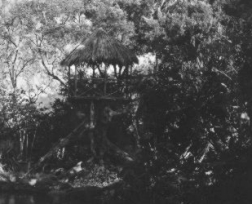
The remnants of a tree-house in RKO's own jungle |
|
Ballona Creek photos courtesy of Joe
Musso and Studio Historian Walt O'Connor
|
Additionally, in Tarzan Triumphs,
some animation was produced for the long shot scene of Buli, the
elephant, pushing Schmidt over the escarpment.
At RKO, an Arab village had been built for the film The
Garden of Allah. It was this village that
we see in four of the six Weissmuller-RKO films. For Tarzan
and the Amazons, Lesser had the hidden
city of Palmyria and mountain entrance built on a sound stage. Both
Johnny Sheffield and Brenda Joyce have commented on how impressive
these sets were. In fact, Lesser, enthused at seeing a rough cut of Tarzan
and the Amazons in December, 1944, pumped
another $100 000 into the pic and reopened shooting. The film already
carried a $500 000 price tag.
The desert scenes for Tarzan's
Desert Mystery were filmed at the Olancha
Sand Dunes at Lone Pine, California.
And for the secret temple of the Leopard Cult in Tarzan
and the Leopard Woman, a combination of
miniatures, matte paintings, and sound stage interiors was used.
For Tarzan and the Mermaids,
Lesser took his people to Acapulco, Mexico. The interiors and
underwater scenes were shot at Studios Churubusco outside Mexico
City, and the exteriors in and around the Pacific town of Acapulco.
The river passing by Tarzan's home was filmed at Puerto
Marqués. Aquatania was Will Beach. The long shots of the
tree-house were the familiar ones used in earlier RKO Tarzan
features. The exteriors of Balu's temple were lensed at the Aztec
ruins of San Juan de Teotihuacán. The high dives were
photographed at La Quebrada, and it was here that stunt double Angel
García was killed as a result of a spectacular dive from the
Acapulco cliff. The caverned lagoon shots were made at Pie de la Cuesta.
For more information on location sites for the Tarzan
films, visit Jerry Schneider's
website.
The
Columbia Films
Corriganville,
named after its owner Ray "Crash" Corrigan, was the number
one location site for the Jungle Jim films. It boasted the famous
Vendetta Village, built by Howard Hughes in 1946 for the film Vendetta,
which introduced Faith Domergue to the movie-going public. Corrigan
often allowed the studios to build on his property, but the sets had
to remain after the filming was completed. He occasionally did this
in lieu of fees. It was this standing village that became Dzamm in The
Lost Tribe.
Also in Corriganville, Robin Hood Lake, recently
renamed Jungle Jim Lake, was built which showcased a Stunt Rock from
which Weissmuller dived into the water. To allow for underwater
photography, a camera house replete with window was built at one end.
This camera house hidden under a bridge was a contribution of Sam
Katzman of Columbia Pictures. It was undoubtedly cheaper than
building a swimming tank on a sound stage. All the underwater
sequences were shot here. The lake may have existed as early as 1938,
and the Rock's first recorded use was in 1943.
The first photo is Stunt Rock as seen in 1991; the
second is a side view of Stunt Rock. The third photo was taken
standing on Stunt Rock, and you can see what remains of the camera
housing from which the underwater scenes of the Jungle Jim films were
taken. And the fourth photo shows a space between a tree and a huge
rock which was often used to simulate the entrance to a valley.
There was also a fake cave entrance built on the
property, frequently used in the Jungle Jim films. It was first
noticed in the filming of the serial Jungle Girl.
The Fake Cave seen June 1999. The right side had
originally been built up with plaster and cement, but disintegrated
over the years. This is all that remains today. It appeared in Jungle
Manhunt and Killer Ape, but not in Jungle Jim in the
Forbidden Land as the sign in the park states.
Next on the list of frequently used sites was
Baldwin's Lake at the Arboretum in Arcadia. Here stood the
Commissioner's quarters and the famous bent palm from which
Weissmuller spearfishes in Mark of the Gorilla.
Johnny Sheffield often swam here as well, not only in the RKO Tarzan
films, but in several of the Bomba movies as well, and he describes
the water as "raunchy."
All interior shots were done on one of Katzman's sound
stages on the Gower Street lot.
Of the remaining locations, the following can be
noted. The coastal settlement in The Lost Tribe,
was lensed at Portuguese Bend. The rocky terrain seen in Mark of
the Gorilla suggests Bronson Canyon , and the mountain and desert
scenes in Fury of the Congo
were photographed at the famous Vasquez Rocks, known for the slanted
rock formations. The long shot views of the rapids in Jungle
Manhunt were probably shot at Kernville,
since that is the closest source of white water to Los Angeles.
Two shots from Vasquez Rocks. The one on the left was
definitely used in Fury of the Congo. The one on the right may
have been used in the same film.
In most of the later films, studio backlots, both at
Columbia and MGM, and sound stages would seem to account for most of
the jungle and rocky terrain. Earl Bellamy states that the MGM rocks
and lake were used for some of the episodes of the Jungle Jim
television series that he worked on.


